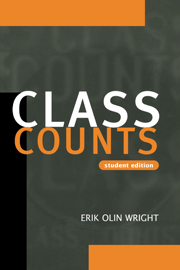Book contents
- Frontmatter
- Contents
- Preface to student edition
- Preface to original edition
- Acknowledgments
- 1 Class analysis
- Part I Structural analyses of classes
- Part II Class and gender
- Part III Class structure and class consciousness
- 10 A general framework for studying class consciousness and class formation
- 11 Class structure, class consciousness and class formation in Sweden, the United States and Japan
- Part IV Conclusion
- References
- Index
- Index of subjects
10 - A general framework for studying class consciousness and class formation
Published online by Cambridge University Press: 22 September 2009
- Frontmatter
- Contents
- Preface to student edition
- Preface to original edition
- Acknowledgments
- 1 Class analysis
- Part I Structural analyses of classes
- Part II Class and gender
- Part III Class structure and class consciousness
- 10 A general framework for studying class consciousness and class formation
- 11 Class structure, class consciousness and class formation in Sweden, the United States and Japan
- Part IV Conclusion
- References
- Index
- Index of subjects
Summary
In one way or another, most class analysts believe that at the core of class analysis is a relatively simple causal structure that looks something like the diagram in Figure 10.1. There is, of course, much disagreement about precisely how to conceptualize the arrows in this causal stream. Do they mean “determines” or “shapes” or “imposes limits upon”? Is there a clear sense in which the horizontal causal stream in this structure is “more important” or “more fundamental” than the unspecified “other causes”? At one extreme, orthodox historical materialism claimed that one can broadly read off patterns of class struggle directly from the class structure, and these, in turn, determine the fundamental course of history; in the long run, at least, class structures are thought to determine class struggle and class struggles (in conjunction with the development of the forces of production) to determine trajectories of social change. At the other extreme, most non-Marxist class analysts as well as some Marxists view the class structure as at most providing us with the vocabulary for identifying potential actors in class struggles; class structure does not, however, necessarily have a more powerful role in determining actual patterns of class struggle than many other mechanisms (ideology, the state, ethnicity, etc.), and class struggles are only one among a host of change-producing factors.
In this chapter we will explore the elements on the left hand side of Figure 10.1: “Class structure → class struggle.”
- Type
- Chapter
- Information
- Class Counts , pp. 185 - 215Publisher: Cambridge University PressPrint publication year: 2000



